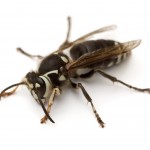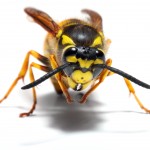 Everyone knows that insects are at full-force in the summer. One of the most common summer pests here in the Sevierville area is the wasp! There are several different types of wasps common to the area, and they all build different types of nests. Some wasps are more aggressive than others and can sting repeatedly. This makes it important to learn about the different characteristics of wasp nests. If you notice any of the below wasp nests in or around your yard, always exercise caution. Keep reading for expert tips from the team at Johnson Pest Control on how to identify different types of wasp nests.
Everyone knows that insects are at full-force in the summer. One of the most common summer pests here in the Sevierville area is the wasp! There are several different types of wasps common to the area, and they all build different types of nests. Some wasps are more aggressive than others and can sting repeatedly. This makes it important to learn about the different characteristics of wasp nests. If you notice any of the below wasp nests in or around your yard, always exercise caution. Keep reading for expert tips from the team at Johnson Pest Control on how to identify different types of wasp nests.
Common Wasp Nests in Tennessee
Many wasps are confused for yellowjackets, but they’re all different in several ways. The easiest way to identify them is to learn what their nests look like:
- Mud daubers
- Their nests are built be female members
- These nests consist of short mud tubes
- Often appear to look like an organ pipe
- Often found under eaves, garages, attics, or on the sides of buildings
- Yellowjackets
- Made out of a papery material and have a single opening
- Interior contains hundreds of cells for eggs
- Some types nest underground, often with thousands of members
- Otherwise build nests in hollow trees, under porches, and a number of other areas

- Bald-faced hornets
- Nests are typically at least three feet off the ground
- Built out of chewed wood fibers mixed with saliva
- Can grow to the size of a football or basketball
- Usually in trees, bushes, or wooded areas, but also can be on buildings
- Paper wasps
- Look like upside-down umbrellas
- These nests are more open, with visible cells at times
- They are typically supported by a single stalk and made out of a papery substance
- Found beneath eaves of structures, in attics and wall voids, and in other enclosed areas
Need Help Identifying a Wasp Nest?
What Should You Do When You See a Wasp Nest?
If you notice a wasp nest forming on or near your property, it’s safest to be cautious around it. Even when a nest appear dormant or empty, there still could be lingering stinging insects inside. When it comes to defending their nests, certain wasps can become very aggressive and either chase or sting you—repeatedly. For that reason alone, it’s best to always enlist the help of your local wasp removal experts at Johnson when you have a wasp nest problem.
 Bald-faced hornets get their common name because they are largely black in color, with a mostly white face. These social insects live in colonies that can contain between 100 and 400 members at their peak. They build nests that are at least three feet off the ground and in exposed locations such as trees, utility poles, overhangs, houses, sheds or other structures. Unlike many other stinging insects, bald-faced hornets do not reuse their nests season after season.
Bald-faced hornets get their common name because they are largely black in color, with a mostly white face. These social insects live in colonies that can contain between 100 and 400 members at their peak. They build nests that are at least three feet off the ground and in exposed locations such as trees, utility poles, overhangs, houses, sheds or other structures. Unlike many other stinging insects, bald-faced hornets do not reuse their nests season after season. These social insects tend to build nests in trees and buildings, as well as in the ground. They are slow to sting unless their nest is threatened, in which case they will become highly aggressive. Unlike bees, yellow jackets can sting several times and inflict severe pain.
These social insects tend to build nests in trees and buildings, as well as in the ground. They are slow to sting unless their nest is threatened, in which case they will become highly aggressive. Unlike bees, yellow jackets can sting several times and inflict severe pain. Paper wasps get their common name from the paper-like material they use to build their nests. Their nests are typically made in the shape of an umbrella. These pests build nests on twigs and in tree branches and shrubs, as well as porch ceilings, eaves and similar covered places. Wasps are capable of stinging more than once and may use alarm pheromones to call for back-up in defending their nest.
Paper wasps get their common name from the paper-like material they use to build their nests. Their nests are typically made in the shape of an umbrella. These pests build nests on twigs and in tree branches and shrubs, as well as porch ceilings, eaves and similar covered places. Wasps are capable of stinging more than once and may use alarm pheromones to call for back-up in defending their nest.